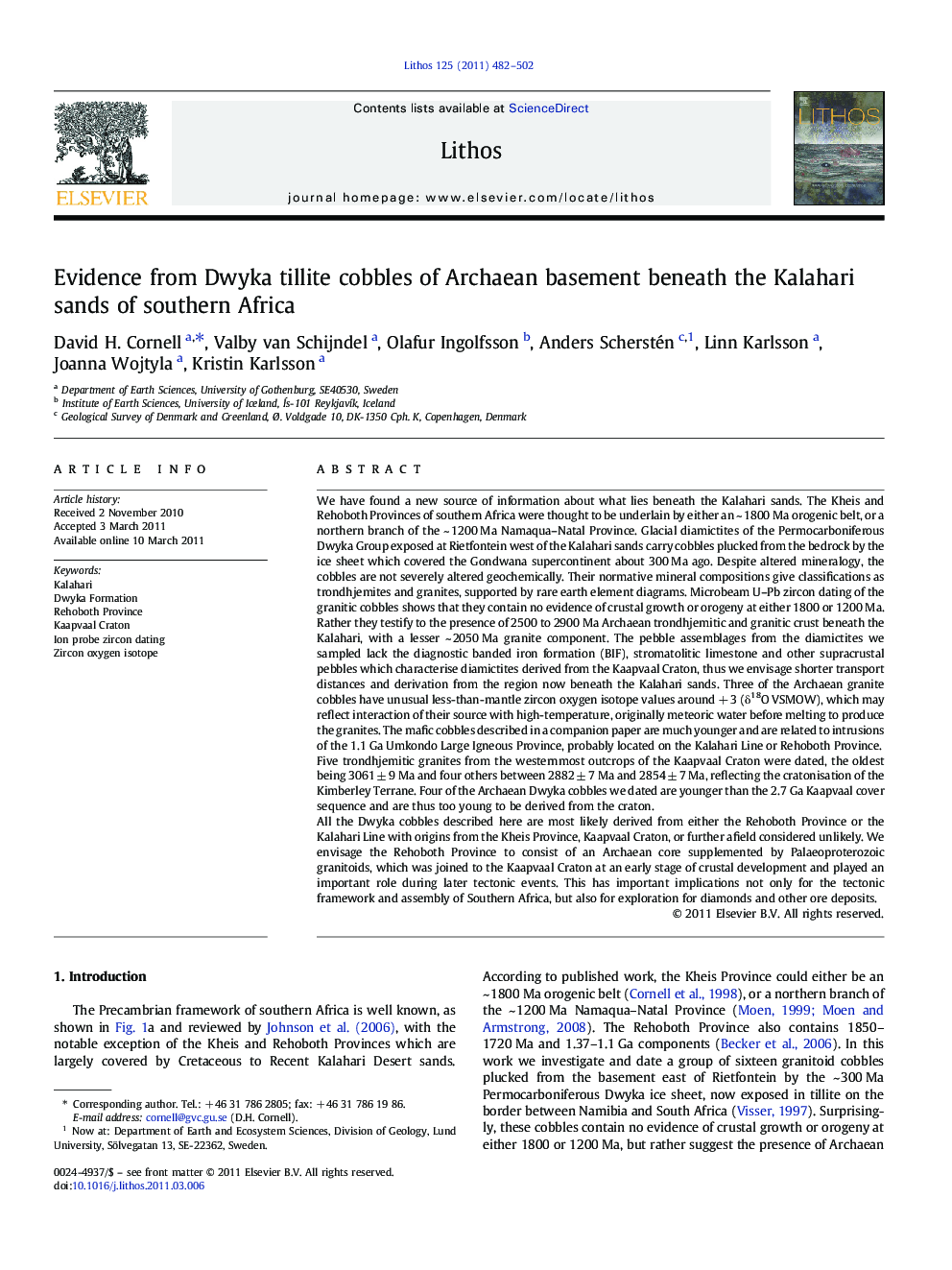| کد مقاله | کد نشریه | سال انتشار | مقاله انگلیسی | نسخه تمام متن |
|---|---|---|---|---|
| 6441174 | 1638719 | 2011 | 21 صفحه PDF | دانلود رایگان |

We have found a new source of information about what lies beneath the Kalahari sands. The Kheis and Rehoboth Provinces of southern Africa were thought to be underlain by either an ~ 1800 Ma orogenic belt, or a northern branch of the ~ 1200 Ma Namaqua-Natal Province. Glacial diamictites of the Permocarboniferous Dwyka Group exposed at Rietfontein west of the Kalahari sands carry cobbles plucked from the bedrock by the ice sheet which covered the Gondwana supercontinent about 300 Ma ago. Despite altered mineralogy, the cobbles are not severely altered geochemically. Their normative mineral compositions give classifications as trondhjemites and granites, supported by rare earth element diagrams. Microbeam U-Pb zircon dating of the granitic cobbles shows that they contain no evidence of crustal growth or orogeny at either 1800 or 1200 Ma. Rather they testify to the presence of 2500 to 2900 Ma Archaean trondhjemitic and granitic crust beneath the Kalahari, with a lesser ~ 2050 Ma granite component. The pebble assemblages from the diamictites we sampled lack the diagnostic banded iron formation (BIF), stromatolitic limestone and other supracrustal pebbles which characterise diamictites derived from the Kaapvaal Craton, thus we envisage shorter transport distances and derivation from the region now beneath the Kalahari sands. Three of the Archaean granite cobbles have unusual less-than-mantle zircon oxygen isotope values around + 3 (δ18O VSMOW), which may reflect interaction of their source with high-temperature, originally meteoric water before melting to produce the granites. The mafic cobbles described in a companion paper are much younger and are related to intrusions of the 1.1 Ga Umkondo Large Igneous Province, probably located on the Kalahari Line or Rehoboth Province.Five trondhjemitic granites from the westernmost outcrops of the Kaapvaal Craton were dated, the oldest being 3061 ± 9 Ma and four others between 2882 ± 7 Ma and 2854 ± 7 Ma, reflecting the cratonisation of the Kimberley Terrane. Four of the Archaean Dwyka cobbles we dated are younger than the 2.7 Ga Kaapvaal cover sequence and are thus too young to be derived from the craton.All the Dwyka cobbles described here are most likely derived from either the Rehoboth Province or the Kalahari Line with origins from the Kheis Province, Kaapvaal Craton, or further afield considered unlikely. We envisage the Rehoboth Province to consist of an Archaean core supplemented by Palaeoproterozoic granitoids, which was joined to the Kaapvaal Craton at an early stage of crustal development and played an important role during later tectonic events. This has important implications not only for the tectonic framework and assembly of Southern Africa, but also for exploration for diamonds and other ore deposits.
Research highlights⺠Cobbles transported by the Carboniferous Dwyka ice sheet are investigated and dated. ⺠Cobbles come from Kalahari Line or Rehoboth Province basement under Kalahari sand. ⺠Granite cobbles fall in only two groups: 3.1-2.5 Ga Archaean and 2.05-2.02 Ga. âºPrevious theories of crustal growth at 1800 or 1200 Ma are not supported. ⺠Archaean basement has significance for mineral exploration and crustal evolution.
Journal: Lithos - Volume 125, Issues 1â2, July 2011, Pages 482-502